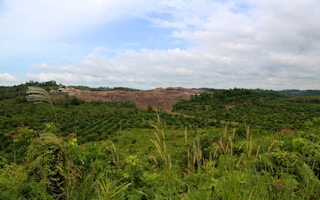Ten major companies that sell and use palm oil have teamed up on a new radar system to monitor forests across Malaysia and Indonesia more closely and speed up action to stop deforestation, a group leading the initiative said on Friday.
The coalition of palm oil producers and buyers will contribute nearly $1.3 million to the project—led by the US-based World Resources Institute (WRI)—which will keep a watch on forests using data from European Space Agency satellites.
“The new technology on one side and the fact that we have all of these big actors in the room coming together to think about how we can best use the information … is really what needs to happen,” said Anne Rosenbarger, Southeast Asia commodities manager at WRI in Indonesia.
Palm oil, the world’s most widely used edible oil, is found in everything from margarine to biscuits, and soap to soups.
But the $60-billion global trade has faced scrutiny in recent years from green activists and consumers, who have blamed its production for forest loss, fires and worker exploitation.
“
The main thing was how we can get more reliable information quicker to help have faster follow-up on the ground so we can intervene where deforestation is happening.
Anne Rosenbarger, Southeast Asia commodities manager, WRI in Indonesia
The world’s top two producers and exporters are Indonesia and Malaysia, and the new radar-based system will cover both. WRI said it would be up and running within two years and could eventually be expanded into other grower countries.
The system will use higher resolution images than existing monitoring initiatives, cover a wider area and penetrate cloud cover. Its data will also be made publicly available through online monitoring service Global Forest Watch.
Rosenbarger told the Thomson Reuters Foundation the ability to gather 10 major market players to work with the new platform “has a lot of potential for impact”.
“The main thing was how we can get more reliable information quicker to help have faster follow-up on the ground so we can intervene where deforestation is happening,” she added.
The online platform will highlight patches in concessions and protected areas suffering tree loss and deforestation.
As well as alerting companies to where action is needed, governments and conservation groups can also use the information to hold businesses linked to those areas accountable.
The palm oil and consumer goods firms in the project —which are already receiving alerts and giving feedback—are Bunge, Cargill, Golden Agri-Resources, Mondelez, Musim Mas Group, Nestle, PepsiCo, Sime Darby Plantation, Unilever and Wilmar.
Many high-profile palm oil buyers have committed to zero deforestation and to source only sustainable oil by 2020, although some are likely to miss their targets.
“We are committed to developing a range of technologies that will enhance and accelerate our efforts to address potential issues within our supply chain,” Petra Meekers, head of sustainable sourcing at Unilever, said in a statement. “Better radar monitoring is an essential piece of this puzzle.”
This story was published with permission from the Thomson Reuters Foundation, the charitable arm of Thomson Reuters, that covers humanitarian news, women’s and LGBT+ rights, human trafficking, property rights, and climate change. Visit http://news.trust.org.










